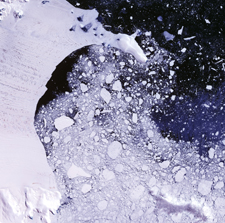 Hemmed in by
two sturdy ice shelves, each about the size of Texas, the West Antarctic ice
sheet contains 3.2 million cubic kilometers of ice. It is the last marine-based
ice sheet on Earth — where ice is anchored to bedrock below sea level.
Were it to collapse due to warming, it would raise global sea level by 5 meters,
catastrophically inundating low-lying areas. Three new studies support that
the breaking away or even the thinning of a small ice shelf could result in
the expected precursors of a collapse — accelerated and thinning glaciers,
increased ice discharge, and rising sea level.
Hemmed in by
two sturdy ice shelves, each about the size of Texas, the West Antarctic ice
sheet contains 3.2 million cubic kilometers of ice. It is the last marine-based
ice sheet on Earth — where ice is anchored to bedrock below sea level.
Were it to collapse due to warming, it would raise global sea level by 5 meters,
catastrophically inundating low-lying areas. Three new studies support that
the breaking away or even the thinning of a small ice shelf could result in
the expected precursors of a collapse — accelerated and thinning glaciers,
increased ice discharge, and rising sea level. This true-color image from Landsat 7, acquired on Feb. 21, 2000, shows pools of meltwater on the surface of the Larsen B ice shelf and drifting icebergs that split from the shelf. Researchers now say that such breakups may accelerate glacier flow out to sea and possibly contribute to sea-level rise. Courtesy of the Landsat 7 Science Team/NASA GSFC.
The Antarctic Peninsula, which reaches northwest into the Weddell Sea toward South America, is one of the top three most rapidly warming places on the planet. In 1995 and 2002, parts of the Larsen ice shelf, which had existed on the east coast of the peninsula since the last ice age, disintegrated. Ice shelves are the floating seaward tongues of glaciers.
A year after the 2002 breakup, Ted Scambos of the National Snow and Ice Data Center at the University of Colorado, Boulder, began monitoring the response of glaciers on the peninsula. Using satellite images to track velocity changes and laser altimetry to monitor elevation changes, Scambos and colleagues found the glaciers were moving two to six times faster and were up to 38 meters thinner, as reported in the Sept. 22 Geophysical Research Letters.
In the same issue, Eric Rignot of the Jet Propulsion Laboratory in Pasadena, Calif., reported similar findings using different methods. Using monthly interferometric synthetic aperture radar data, Rignot and colleagues found the glaciers had sped up significantly, some up to eight times faster than before the 2002 breakup. They also monitored adjacent glaciers that retained their ice shelves, thus allowing a controlled case comparison. The glaciers buttressed by ice shelves showed no change in velocity or thickness.
“What both Scambos and Rignot are reporting now is that sure enough, you take away an ice shelf, and the glaciers that feed it respond to that by accelerating” out to the ocean, says Robert Bindschadler, a glaciologist at NASA Goddard Space Flight Center in Greenbelt, Md., and chair of the West Antarctic Ice Sheet Initiative. The big question, Bindschadler says, is whether the climate warming seen on the peninsula will work its way south to the West Antarctic ice sheet, which is already experiencing some warming.
Along the west coast of Antarctica, multiple glaciers from the West Antarctic ice sheet feed small ice shelves in the Amundsen Sea. In the Sept. 23 Science Express, Robert Thomas, a glaciologist at NASA’s Wallops Flight Facility in Virginia, reports that interferometric radar data show substantial shrinkage of the glaciers since the 1990s. And they are now discharging 60 percent more ice than they accumulate, raising sea level by 0.2 millimeters per year, which is 10 percent of the global rise.
“We see the ice getting thinner, and the rate at which it’s thinning appears to be accelerating,” Thomas says. He also found that, contrary to previous thinking, changes at the seaward margin of a glacier seem to be promptly “felt” far inland on the glacier, 100 to 300 kilometers.
But exactly why the Amundsen Sea glaciers have accelerated recently remains unknown. Researchers know the shelves used to be more substantial and that they are now thinning 1 to 3 meters per year.
“What is seen in the Amundsen Sea looks a lot like what is seen in the Antarctic Peninsula: accelerating and thinning ice at the perimeter,” Bindschadler says. “But whether that’s in response to this prehistoric ice shelf disappearing or whether it’s a separate dynamic process, we really can’t say.”
If the Amundsen glaciers are thinning because of ice-shelf weakening, and the glaciers are rapidly feeling the effects far inland, Thomas says, “it totally changes the possible dynamic response to future changes in climate because these shelves exist at sea level and are very vulnerable to warming.” Sea-level models are currently not considering this possibility, Thomas says.
The Amundsen Sea drainage basin holds enough ice to contribute to a sea level rise of 1.2 meters. If the ice shelves were removed, “we might have a situation where [the glaciers] could go many times faster than they go now,” Thomas says, moving the ice out to sea. “In that case, the sea-level rise could become appreciable, and we’d have to worry about it.”

